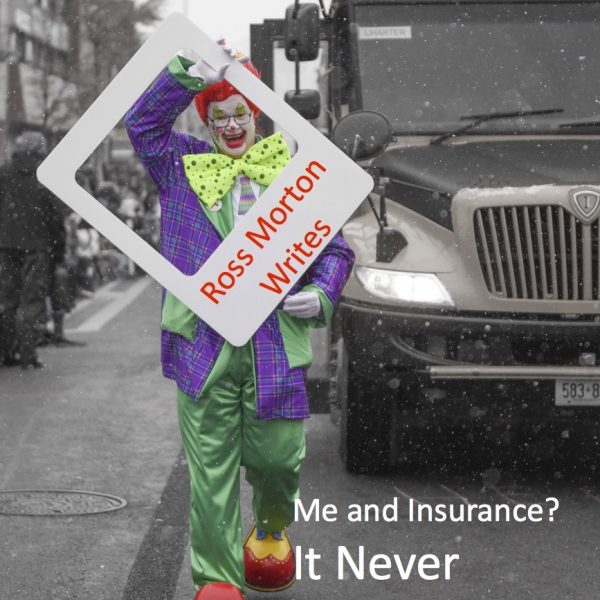I joined Manulife Reinsurance Division in January 1990 and stayed until May of 1994. The mandate I carried was for traditional retrocession business. Manulife had been number one but was slipping and my team’s job was to regain the number one position in retrocession world in both reputation and production. Again I had the advantage of a world class team of people who went the extra mile to polish the image and be the most efficient and prolific “retro” on the planet. I never did fit the politics of Manulife and even had psychologist who were doing their routine reviews of all senior executives (I was number 26 out of 26 world wide!) tell me I would lose all my strengths and become a typical Manulifer if I stayed. I wanted to remain me and maintain my advantages as I saw them which for the previous twenty years had been so sought after by other companies and people.
Steve Carlson the editor and publisher of Marketing Options was a great editor and like all the articles I wrote for his magazine his touch and mastery of the written word helped me refine my writing score while letting me be me! Thanks Steve for this and much other editorial wisdom you bestowed upon this rookie writer.
Manulife remains a prominent retrocessionaire in a market that is more fiercely competitive than ever and where margins are close to insane. The team spirit has maintained its prominent role as a core competency among the troops of Manulife Re. They never did stick to the short form ManuRe thank goodness.
Ross
2004-04-07
Marketing Options
June 1990
The amount the client needs is $5,000,000. The amount you sold is $5,000,000. Why would anyone not want to sell more at these great rates?
As a well-educated and experienced agent, you have worked for months to arrive at the point of final presentation of the product that best suites the applicant’s needs. The numerous details to complete the application form have been garnered through a barrage of questions that make the Home Office underwriter’s job easier. Now comes the moment of editing the sale and making sure that all the t’s have been crossed and I’s dotted. Panic sets in as that tiny asterisk catches your eye and you scan to the long tail (* RATES ARE AVAILABLE FOR AMOUNTS UP TO $2,000,000 ONLY) that attaches to the other asterisks on the back page of the rate card of four screens later on your laptop.
After you have extradited yourself from immediate embarrassment with your prospect, you hear from your co-operative insurer that the retrocessionaires want higher premiums to participate in this plan. Just when you thought you had captured the essence of reinsurance or at least had become accustomed to its presence, along come the terms ‘retrocessionaire’ and ‘retrocession’.
The reinsurers are just great in their support of this innovative and aggressively priced plan, your co-operative insurer explains, but those stingy retrocessionaires will not cooperate and insists on fatter rates. They are the specialists, you are told, that must be approached by the reinsurer for retrocessions (or more coverage) when the sale exceeds $2,000,000 and your reinsurer’s capacity.
Your immediate reaction is probably “does this never end?” or “just where does the buck finally stop?” Having heard and witnessed the frustration of agents with reinsurers, I can finally comprehend how this situation would have the agent perplexed once again.
How does this situation arise? Today’s life insurance market is extremely competitive and a balance of aggressive pricing and innovative plan design often puts the pricing actuary and marketing executive in a position of market leaders. Those two people (sometimes rolled into one) must try and convince one or more reinsurers to support their pricing of the plan. If they are lucky, five reinsurers will provide support in the form of a price that allows the company to reinsure its excess business without losing money or interfering with the agent’s remuneration.
In the free enterprise system of reinsurance, the lowest bidder for the ceding company’s (in this case, the life company’s) excess business wins.
Now what we have is the originating life company designing a competitive product to sell more for less to the public. Keeping it simple, the price is such that most other life insurers are unable to match the price. One reason is that the winning reinsurer who for its retention, offers the lowest price of say five, worldly, knowledgeable, aggressive reinsurers, it is not likely to offer another life insurer the same rates for a copycat plan-not if that reinsurer ever wants to do business with the originating company again. The winning reinsurer’s price has been keenly stripped of every vestige of extra pricing margins, that is: morality, investment, administration and profit. Because the ceding company and reinsurer have combined retention of only $2,000,000, yet a market that often buys more, the search for a retrocessionaire(s) commences.
Starting with the premise that the price is very thin, one can assume the retrocessionaire’s price must be even thinner because the retrocessionaire’s price is stripped of the most of the reinsurer’s margins. There are three general results that can occur.
First, retrocession capacity is significant amounts is found to remove tiny * off the rate card. The price needs no adjustment. Unlimited capacity is a sign that three or more pricing actuaries have agreed on price, commission and product design, which is mean feat!
Second, no facilities are found at the price and the tiny *is necessitated. To boldly accept a $1.00 premium (which is that portion of the life company’s premium to the reinsurer that the reinsurer may be able to subsequently allocated for retrocession’s) and pay out $1.50 for risk coverage (which may be the best price any retrocessionaire is able to offer) does not normally appeal to a reinsurance company.
Third, a cooperative structuring of premiums and commission is discovered that allows all parties to achieve their goals. The reinsures pays the retrocessionaire the thin risk premium and collects same from the insurance company. The reinsurer acts as a conduit for the excess risk but receives no payment for the service, treating it as a fact of keeping the ceding company’s business. The ceding company and agents, in their joint effort, agree and accept a reduced commission respectively.
Within the extremely competitive large case market the balancing of price, commissions and total capacity becomes very important to all parties. If the agent expects the lowest priced product, it may be at the expense of limiting the total capacity in the market. (A more moderately priced product, for example, would have a much higher total capacity with more retrocessionaires able to provide coverage for the higher premiums available.) In the majority of sales the total face amount available for the lowest priced product is often enough but in the odd case the tiny * can ruin your day if it catches your eye at the last moment.
Finally, what do you call a company that accepts excess business from a retrocessionaire? Only printable answers, please.

